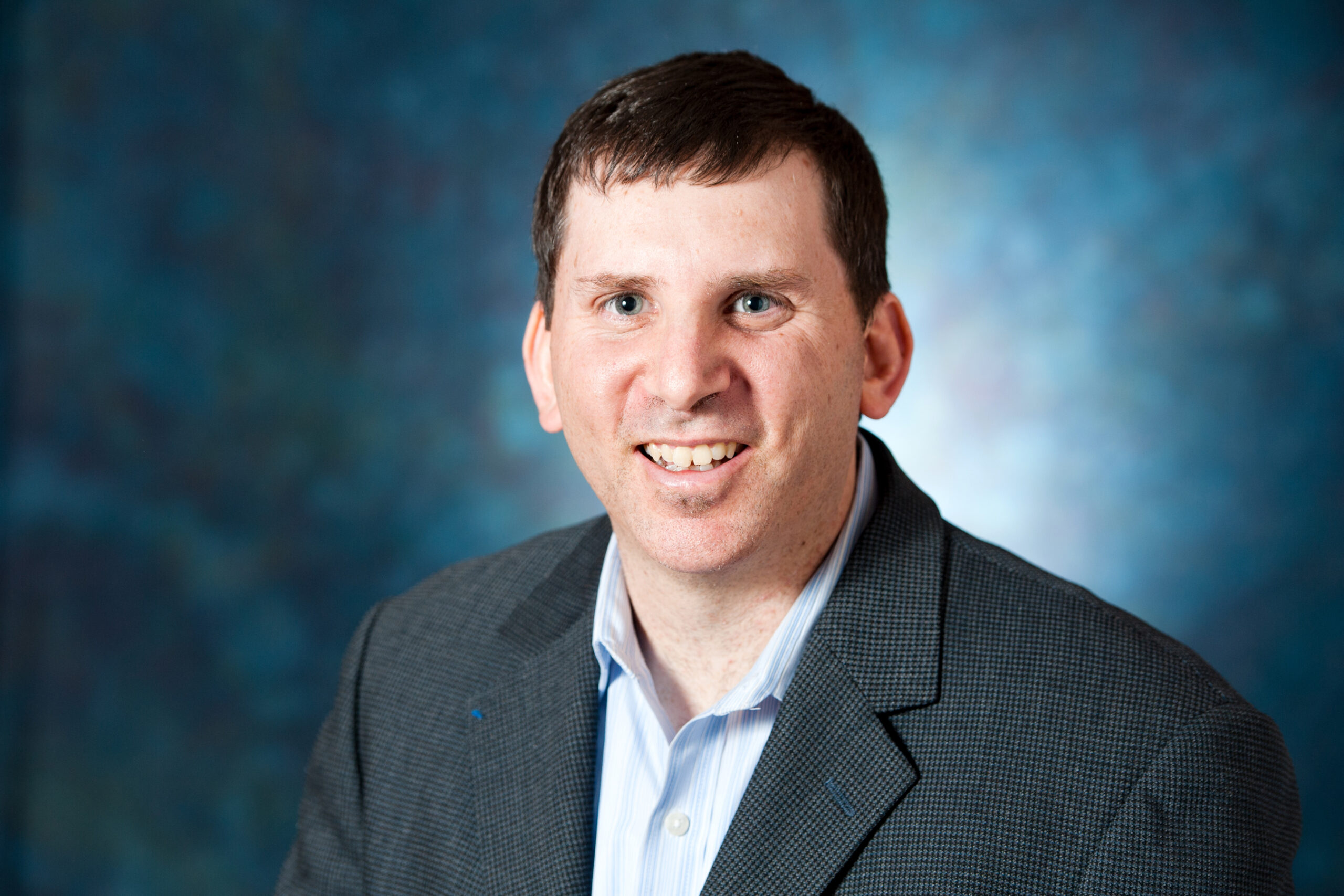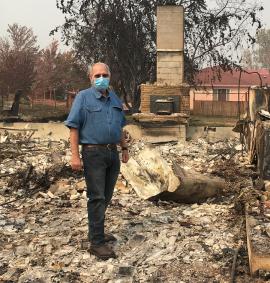 Don Steyskal stands in the ruins of the family home in early September, 2020.
Don Steyskal stands in the ruins of the family home in early September, 2020.
Don and Karen Steyskal were among the fortunate ones: The couple had managed to land a hotel room. Their Talent, Ore., home — along with about 2,000 others in the Rogue Valley — was incinerated in early September by a once-in-a-generation series of wildfires. They escaped with 15 minutes warning.
Yet, circumstances didn’t prevent the Steyskals from taking part in Temple Emek Shalom’s virtual High Holiday services. From their cramped room — shared with three dogs and a cat — Don chanted Torah and led several prayers.
“It was different. But I was really able to appreciate this sacred time. Especially on Rosh Hashanah, I was thinking that I have the New Year, and my wife and I are getting started on a new life,” said Don Steyskal.
In many ways, the Steyskals’ — and Emek Shalom’s — High Holiday experience epitomizes a transformed Judaism in 2020, a year defined by pandemic, economic collapse, protests for racial justice, political disarray and, in the case of much of the West Coast, catastrophic fires. Yet Jewish life went on, proving to be both adaptable and vital. Reconstructionist congregations have adapted, based on millennia of precedents and an unceasing commitment to community.
During these long months (or have they passed by in a flash?), thousands have turned to Reconstructionist communities as a bulwark against isolation and a way to explore meaning in a time that often seems senseless. Many are forging deeper connections to congregations in their proverbial backyard, while others have found spiritual sustenance via a community that may be a continent or ocean away.
Reconstructionist rabbis and affiliates have launched affinity groups, shortened services, hosted online musical festivals and educational programs while adapting longstanding activities to Zoom and other digital spaces. As evidenced by the numerous digital daily minyanim that have launched across the movement, Reconstructionist affiliates are playing vital, daily roles in people’s lives in ways that hadn’t been possible before. Many communities have seen participation rates soar. For example, Shabbat service attendance has more than doubled at Congregation Beth Am in San Antonio.
“I deeply believe the existential nature of the pandemic has contributed to a religious revival,” Rabbi Deborah Waxman, Ph.D., president of Reconstructing Judaism, recently told the Forward. “Those of us who have been really protected from life-or-death questions are facing them in a way that our ancestors did. [People] are looking for religious answers and the solace of community.”
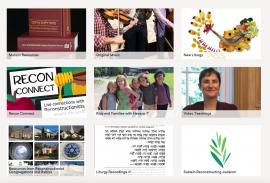 Reconstructing Judaism provided rich High Holiday resources, freely available to all.
Reconstructing Judaism provided rich High Holiday resources, freely available to all.
In many cases, this work was made possible, or at least easier, by Reconstructing Judaism, which made digital prayer books and other resources freely available, helped affiliates think through logistical challenges, and provided an array of content that enabled communities to celebrate holidays more fully. Among the platforms introduced is Recon Connect, a webpage where congregations can post their live online events and people can register to participate. (To learn more about Reconstructing Judaism’s pandemic response, click on our 2020 Annual Report Video: https://youtu.be/NezBjjPD5Cs)
Commitment to Relational Judaism
At the onset of social distancing — and, later, the fires — southwest Oregon’s Emek Shalom maintained its commitment to the practice of relational Judaism. The term was popularized in the 2013 book of the same name by Ron Wolfson, a professor of education at American Jewish University in Los Angeles who has urged Jewish communities to shift their focus from creating programs to cultivating relationships.
During the initial lockdown, Emek Shalom adapted a system it already had in which its two religious leaders, Rabbis Joshua Boettiger and Julie Benioff, and members of the board would reach out to a specific number of congregants, ensuring all 200 member families heard from the congregation on a regular basis. Early on, Emek Shalom was able to identify members who weren’t leaving their homes and recruited volunteers to help them with grocery shopping and other errands.
“It’s been a lot of old-fashioned hard work. We don’t have any secret sauce,” said Ben Bellinson, an Emek Shalom vice president. “After the fire, we identified people who were in that zone. We were able to identify their needs. These people need food. These people need a place to stay.”
In addition to assisting the five Emek Shalom families that lost homes, members have mobilized to find temporary housing for working class Latinx community families made homeless by the fire, often with little or no savings. (For information on how to assist fire victims visit https://roguevalley.recovers.org/.)
As for the Steyskals, the couple plans to live in nearby Medford for several years until their Talent home can be rebuilt.
“Our home was completely and totally destroyed. It is a pile of ash right now. The whole thing is a realization: Everything we have been through has gotten us to a point where emotionally and spiritually we can survive something like this,” he said, noting that numerous fellow congregants donated to a GoFundMe campaign used to purchase much-needed household goods and clothing. “The role Emek Shalom has played is just being there. Just the knowledge that it is available is very comforting.”
Karen Steyskal was equally appreciative, though her comments more closely reflected the ambivalence expressed by some about the online prayer experience.
“You don’t feel the group rapport and energy on Zoom,” she said. “It is acceptable; it is not the best thing. On the other hand, we’d be completely cut off if we didn’t have this technology. As many hateful people as there are in the world, we have experienced love and concern and help.”
Situated some 180 miles to the north in Eugene, Ore., Temple Beth Israel also had several members who lost homes due to wildfire, though everyone currently has adequate shelter.
At the start of the shutdown in March, Rabbi Ruhi Sophia Motzkin Rubenstein also thought it was vital to be in regular touch with members, not only to check in, but to provide pastoral counseling when needed. (Rubenstein also biked around the area and had socially distanced visits with a number of members.) Since Temple Beth Israel has some 400 member families, doing so posed something of a logistical challenge for one rabbi. Rubenstein sought volunteers and initially found 40 people to commit to calling 10 people per week. The goal was to connect with every adult member, including multiple people in the same household. She offered training on pastoral conversation basics — don’t talk about yourself unless asked, allow space for silence — with the understanding that certain issues would be referred to the rabbi. Rubenstein also provided a script for leaving a voicemail. Member Bev Behrman has run the effort.
So far, 100 people have volunteered to make calls, with members rotating in and out. Seven months in, about a third of members have opted out of receiving the call, and a third will pick up some months and other times let the call go unreturned.
“And then there is a large minority that sees those calls as a lifeline,” said Rubenstein.
Craig Weinerman, a retired lawyer, is among the volunteers making the monthly calls. Doing so, he said, gives him a chance to contribute to his community and, in some cases, reconnect with people he’s known for years.
“People appreciate that the synagogue is concerned about them and is offering help,” noted Weinerman.
Sometimes, when members ask for help with something, he’s followed up himself, such as one time when a man needed help learning how to connect on Zoom. Weinerman also picked up a High Holiday prayer book for the man since the member was homebound. Other times, such as when a nursing home resident reported feeling isolated, he passed that on to the rabbi.
“I’m not a social worker, I don’t give advice. I’m retired, this is the least I can do,” he said.
Daily Digital Minyan
Several religious leaders interviewed echoed that another way to check in on folks, and to ensure community, is to offer daily, or near-daily programming. Especially in areas where people may live far from their congregation, few expect people to show up to a building every day. But logging on from home is something else entirely.
“We are not a congregation that has ever had a daily minyan,” said Rabbi Alanna Sklover, who in the summer of 2019 became spiritual leader of Or Hadash in Fort Washington, Pa. “I had this notion: What if we had our own daily minyan? We landed on Minyan Hadash. This might be the most Reconstructionist morning minyan I have ever participated in in my life.”
While Sklover sometimes leads the daily Zoom gatherings, usually it is run by members. Minyan Hadash typically includes a spiritual practice such as meditation, yoga, text study, chanting and, sometimes, traditional prayer. It also provides an opportunity for people to check in on one another. “It has been incredible hearing these different voices come to the fore. Reconstructionist rabbis are guides on the side. When things are working well. We are not the ones calling the shots.”
At New York’s SAJ-Judaism That Stands for All, daily programming takes the form of “Wake Up with SAJ.” From mid-March through the present, 15 to 25 people have gathered Monday through Friday for a meditation, morning prayer and a reflection on a psalm. With many members, especially the elderly, rarely leaving their homes, the gathering proved a social and communal lifeline. Additionally, people have attended who live outside the New York area, a few belonging to smaller Reconstructionist congregations that lack the staffing or numbers to run a daily minyan.
“There are people who have not missed a day,” said Rabbi Lauren Grabelle Herrmann, who led every gathering during the initial months but now shares those duties with rabbinic intern Noah Rubin-Blose, and lay leaders.
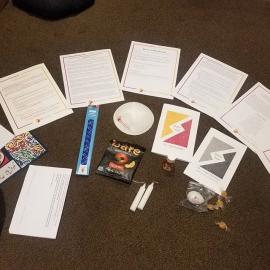 SAJ reinforced its physical connection with members through Rosh Hashanah bags this year.
SAJ reinforced its physical connection with members through Rosh Hashanah bags this year.
Days after New York City first introduced lockdown measures, SAJ built support networks, organizing three virtual, weekly groups for seniors, working adults, and parents with middle and high school children. (Parents with younger children, Grabelle Herrmann found, were overwhelmed and connected primarily through Hebrew school.) In addition, SAJ organized twice-weekly meetings for high school students and new adult learning classes on a wide range of topics.
“We’re trying to address the loneliness of the pandemic. We have members who went from living a normal life to spending months indoors without going outside. We were able to have their spiritual home stay constant and be what helps them get through these difficult times. We are addressing the loneliness [and] also making sure that no one gets left out” said Grabelle Herrmann, adding that an SAJ staff member conducted one-on-one Zoom trainings for dozens of members to ensure their participation.
SAJ member Barbara Nussbaum, Ph.D., is one of the organizers of the parent group and also leads a meditation group. Her daughter, Izy, teaches in the religious school and is active in the synagogue’s youth group. Throughout the pandemic, the congregation has been a vital source of support for the family, at no time more so than in April, when Nussbaum lost her mother, and SAJ organized a virtual shivah.
“Being part of a community that has already been established has been crucial for us,” said Nussbaum. “Without the virtual shivah I would have felt much more lonely and cheated out of mourning rituals.”
Richard Ruth, a member of Kol Ami in Northern Virginia since the early 2000s, long wanted to be part of an egalitarian, actively LGTBQ- affirming daily minyan. There never seemed to be time, or opportunity. That is, until Kol Ami went virtual in March.
With a shared sense of need to build community and support for each other during the pandemic, there was a critical mass of interest among congregants. Ruth said the minyan began meeting four mornings a week — a small synagogue doing what it felt it could sustain.
He lives what he described as “an empowered life with disabilities” and no longer drives. That wouldn’t have precluded him from davening regularly and sometimes leading a morning minyan at the synagogue but participating in the Reconstructionist minyan from home has been much easier. And many more of Kol Ami congregants have been, and remain, ready to participate online and take advantage of the opportunity to feel seen and heard and check in on one another. Minyan leadership rotates among a committed group. (Click here to learn about Kol Ami’s policy of radical inclusion and the process the congregation undertook in opening their entire worship practice to non-Jews.)
“In some ways, it is like spiritual coffee in the morning. In other ways, it feels like being part of the living crucible of tikkun olam,” he said.
 Kol Ami teens participate in Pizza and Talmud on Zoom.
Kol Ami teens participate in Pizza and Talmud on Zoom.
The professor emeritus of clinical psychology at The George Washington University also continues to lead a weekly teen program, “Pizza and Talmud.” In the online version, the half-dozen participants make English muffin pizzas. The group also follows an important Talmudic teaching: Start with dessert.
“These kids are amazing,” Ruth said, noting that at least one participant came with no prior Jewish education; others have had b’nei mitzvah, and some help teach in Kol Ami’s religious school. “I present the Talmud as a resource in a Jewish context that respects them as the burgeoning adults they are.”
Debra Linick, Kol Ami’s immediate past-president, noted that she might have expected a congregation of less than 100 families to struggle during the pandemic, but, since March, Kol Ami actually has grown by 10 percent, from 65 to 71 member families, with new folks hungry for community and more than willing to take part in online gatherings.
Among those who have joined in the last six months are Arlington, Va., residents Andrew Keller and Anya McMurray and their 8-year-old daughter and 6-year-old son. The interfaith family — McMurray identifies as Unitarian — has sought a welcoming Jewish community and had attended in-person events at Kol Ami prior to the congregation’s transition to virtual meeting.
“We were interested in Kol Ami because we were attracted to its approach to Judaism. It was compatible with our values,” said Keller.
The children have taken part in Tot Shabbat services and religious schools. And while the parents haven’t participated as much as they would have liked, they’ve felt embraced by the community, even if the connection has happened largely in virtual space.
“It is a super warm and inviting community. We have been really appreciative,” Keller said.
Diverse Online Offerings
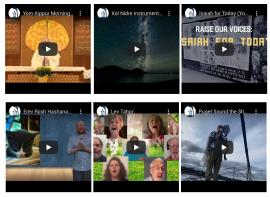 Videos of High Holiday services at Temple Beth Hatfiloh in Olympia, Wash.
Videos of High Holiday services at Temple Beth Hatfiloh in Olympia, Wash.
Over the past few years, “Shabbat Salon” has been one of the most popular programs at Temple Beth Hatfiloh in Olympia, Wash. Pre-pandemic, the program involved a catered meal together followed by a variety of guest speakers. Since March, dozens of members are still taking part, picking up the catered meals in advance and participating at home. Rabbi Seth Goldstein credits his training at the Reconstructionist Rabbinical College with being willing and able to pivot quickly.
“This is our reality. So how can we respond creatively in the moments and meet people’s needs? How can we continue to meet people where they are and bring Judaism to a meaningful place in their lives?” said Goldstein.
He pointed out that, while non-Orthodox life has, by and large, taken place online, some in-person activities have taken place following safety guidelines.
A common refrain from congregants was that they sought a safe, socially distanced way to gather, at least for a little while. Temple Beth Hatfiloh tried something it never had before. While nearly all High Holiday services were held virtually, Yom Kippur yizkor, the memorial service to the dead, took place at the congregation’s cemetery. Yizkor was also livestreamed.
“It was very powerful and moving,” said Goldstein. “People appreciated the chance to do something in person. I got some feedback that it might be something we might want to keep.”
In San Francisco’s Or Shalom Jewish Community, what began as planning for an in-person music festival has, by necessity moved online. Koleynu, Hebrew for “Our Voices,” is, according to Or Shalom’s website, “a virtual gathering that weaves together music, spiritual practice, activism and wisdom from Judaism and other faiths.” So far, hundreds, including many from outside the San Francisco Bay Area, have taken part in two Koleynu gatherings, which have featured performers and rabbis from around the Reconstructionist movement and beyond. They are part worship, part concert, and part catalyst for action. (Click here to check out the first Koleynu gathering, or click here for the second.)
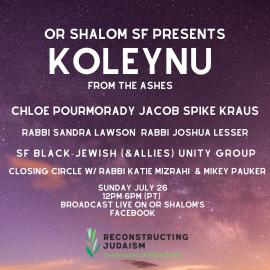 Promotion for July Koleynu event sponsored by Or Shalom Jewish Community in San Francisco.
Promotion for July Koleynu event sponsored by Or Shalom Jewish Community in San Francisco.
“Our goal is to create an immersive experience that people can enjoy, wherever they may be sheltering,” said Rabbi Katie Mizrahi.
Is it too early to think about what lessons from virtual gatherings can be applied to whatever comes next?
“There is a nostalgic tendency that can be destructive. How can we get back to normal? The reason this pandemic is such a disaster is that things were not healthy before. We need to aim higher than ‘normal.’ We need to use this disruption of the time for profound structural change,” said Mizrahi, speaking in larger terms related to health care, racial justice and climate policy, but also for Jewish life as well.
It seems all but certain that in-person gatherings are essential and will return, but that virtual spaces will continue to play a vital role, Mizrahi added.
“When the pandemic first happened, I thought, this is what our community is for; this is what we were made for. We give people hope and strength and meaning during difficult times, whether it is helping to foster connections or give people practices that they can lean into,” she said. “The way that Reconstructionist Judaism approaches change is so helpful. There is a fearlessness about it. We greet change like a familiar, generative thing, adapting to this moment. This is what rabbis have always done, especially in moments of great transformation.”
Affiliates that want to make their live online events available to members of the Reconstructionist movement can submit their event information here. The events will appear in a listing here.

